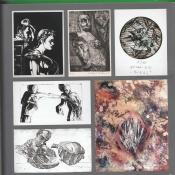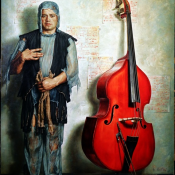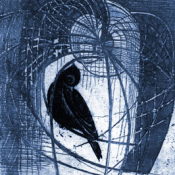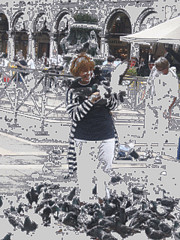Creation Category:
 | |
| Ileana Costea talking to Jerry W. McDaniel, September 2010 |
 |
Cititi articolul in Romana = Article in Romanian
Interview by Ileana Costea, Professor at California State University, Northridge
Ileana Costea, a University Professor in Los Angeles, talks to Jerry W. McDaniel, a well-established New York fine artist, who currently lives in California. Jerry has shown his art in numerous solo and group exhibitions and has original work in many collections including The Metropolitan Museum of Fine Arts in New York, the Smithsonian, The US Air Force Art Collection, as well as in private collections in the US and Europe. Mr. McDaniel’s work has been published in many books including “The Illustrator in America” and “Icons and Images.” In 1971 Jerry was one of the founding members of the Advertising Design Department, Fashion Institute of Technology FIT/SUNY, New York, NY, whose Chair he became in 1994. He earned an MA in Computer Communication Art from the New York Institute of Technology (NYIT) in 1987. He is a member of The New York Society of Illustrators (SI), Broadcast Designers Association (BDA), The American Institute of graphic Design (AIGA), and The Graphic Artist Guild (GAG).
Recently Mr. McDaniel designed the Invitation and Catalog Cover of the upcoming SalonARTIS2010 to be held 2 - 16 October, 2010 at “Galeria Artelor” in Bucharest Romania. Mr. McDaniel is one of the Guests of Honor of the event, and will present two paintings in the exhibtion (www.jerrywmcdanielstudios.com/SalonARTIS2010).
In the interview Mr. McDaniel talks about his art and how he got to know Romanian culture and art.
September 21, 2010, Los Angeles, California
 |
Cititi articolul in Romana = Article in Romanian
IC: I know that you just did the design of the invitation for the upcoming exhibition SalonARTIS2010 to take place in Bucharest, Romania, October, 2-16, 2010, at “Caminul Artei” Gallery. The same design will also be used as the cover of the catalog for the exhibition. How come you did this invitation/cover design?
JWMcD: I've designed many “covers” in my life: Art Director Pat Smythe hired me for College Education Textbooks Prentice Hall, New York, then I did the entire collection of the Western stories of Zane Gray for Simon Schuster Pocket Books, and I worked on the books of S. S. Van Dine for six publishers, which became famous through movies in the 20’s and 30’s and through a TV serial. I like the fact that the SalonARTIS is doing the exhibition as a replica of the Line and Color French Association. My art is based on line, shape, texture, and, of course, color.
IC: Can you explain more?
JWMcD: Yes, everybody who sees my paintings notices that color is my “thing.” I learned color from Joseph Canzani, my art professor and long time Dean and later President at the Columbus College of Art and Design (CCAD).
He was emphasizing the importance of color in painting. I also got a strong impact about color from Van Gogh, the first European artist I saw an exhibition of, in Toledo,Ohio. A big Van Gogh retrospective where Canzani took the entire art school to the Toledo Museum by bus to see it, so that we can learn lessons from a master. That show made a very strong impression on me. For several years I was working in the Van Gogh style, to the point that Canzani reprimanded me for being so influenced by the master, and only this determined me to detach myself and work in my own color style. I also studied with Angelo Seville and Henry Pearson at the New School for Social Research in New York. As for the “line” part of my connection with the “Ligne et Couleur” exhibition, I always try to do my work in a Mondrian style: borders of geometric shapes must flush with each other, must have tangents, there must be order in a painting. Once you have order, you can apply a twist.
IC: What is your connection with Romania, though?
JWMcD: It all started by me being asked to do some paintings inspired from Lucian Blaga’s poems, when you, yourself, invited Lidia Lazu, the Romanian actress to do some shows in California, in 2008. As an American, I am sorry to say, I did not know about this poet. I read his poems in a very good translation by Adrian Sahalean. Then I asked a Romanian friend to show me some art from Romania. I went through several books of Romanian folk art, pictures of Maramures. I looked at Romanian Art Volumes. I especially felt an artistic connection with Tuculescu’s paintings: his colors and order in his compositions. For my own pleasure I did some sketches inspired by Tuculescu. The funny thing is that they are in black and white, and not in color. In May 2008 I did several paintings based on Blaga’s poems that Lidia was to recite which were used as stage background for her shows. Maybe one day I will try to publish these Blaga-inspired paintings in a book accompanied by Lidia’s singing. Her shows are not just reciting. She also moves in a symbolic rythmic dance way and sings, some beautiful nightingale thrills that she improvises. It is what I like to call “Romanian jazz.”. I also used the motif of the wooden sculptured pillars of the famous Maramures gates in a painting I did for a Romanian couple from Paris, Cristina and Adrian Topala, on the occasion of the marriage of their daughter Alina, to Jason, an American from Nebraska. I never visited Maramures but I had the opportunity to see a golden gate sculpture by Mircea Cantor in full one-to-one scale at an annual art exhibition in Paris, in the Art Nouveau Hall of the Grand Palais.
| |
IC: Is Tuculescu the only famous Romanian artist you are familiar with?
JWMcD: No. I also know Constantin Brancusi’s and Nicolae Grigorescu’s work. Brancusi appears in almost any art history book published in English. There are two Bird of Paradise scultpures by Brancusi in Los Angeles, the city I live in now, one at LACMA (Los Angeles County Museum of Art) and Northon Simon Museum. The latter being the museum of art I like best in California. I also saw Brancusi sculptures at the Museum of Modern Art in San Francisco, and this summer, at the new Centre Pompidou in Metz, France. There Brancusi was present with several of his works, a sculpture, some drawings, a painting, and some photographs of his Paris studio. I also had the opportunity to visit the house in which Grigorescu lived, in Campina, Romania. Grigorescu is too clasical an artist for me. I like modern art especially. I relate to Brancusi because of the way in which he simplifies shapes, he captures the essence, he gives you hints rather than making reallistic representations.
IC: Well, it seems that you like Europe? Yet you are very American.
JWMcD: The more I meet Europeans, the more I realize how American I really am. I know I am, for I like Hamburgers, and hot dogs, I need ice-cubes in my whisky glass (and they do not have it in Tarom Arline planes, neither in German bars…). A Romanian friend of mine, Smaranda Shaechtelle, who works in the Fashion Design field in Dusseldorf, told me when I first met her, a few years ago: When I listen to you, Jerry, it is like watching an American movie. Only then I realized how American my accent and way of speaking really is.
IC: How would you summarize your European connection?
JWMcD: First, I was married for many years to an European. Renata, my first wife, and mother of my two children, was a Miss Berlin. We met in New York and she is the one who taught me how to dress. She used to buy my clothes for me. We gave our children European names: my deceased daughter, Saskia was named after Rembrand’s first wife, and our son has the name of the last Ostrogot king, Teja, a writer, director and film maker in Australia. Recently I spend my summers in France. My studio in Paris is in Montparnasse. I know it might make you smile, for you might think about the fact that several American artists and literary personalities lived there, such as Heminguay. Brancusi lived and worked there too. In my case it just happened to have found a place there. My summer headquarters are in Paris, but I also spend time at my dear friend Brigitte Fontaine in Nimes. I travel through Provence, admire the lavander fields, and Roman remains, Colliseums, Arches of Triumph, Aqueducs. Each time I go there I also visit the vice-mayor of a small village near Aigues Mortes, in Aigues Vives, Bane Georgescu, and his wife Mugura. I can not stop my amusement to see that a Romanian became a mayor in France. I also like to travel to Brittany to go fishing in the Mediterranean Sea like the locals do with my French friend Claude Danoffre. Food in France is a delight and partying with the French is quite something. I was part of their son Vincent’s 35th birthday celebration this summer at Claude and Ghyslaine in Plouah. Some of the guests spoke English. But watching their “joie de vivre” was a pleasant experience. I find the same with my Romanian friends. I am a visual person, I can watch movies in any language, be it French or Japanese, I am not bothered by mingling with people who can not speak my language. Non-verbal France is beautiful: the man on a bicylce with a baguette, the big boats on the muddy sea bottom at low tide in Brittany, the purple lavender fields in Provence, the loud crowed at the Caffe du Roy under my window and the numerous food stores on my street in Montparnasse.
| |
IC: You say the more you meet and get to know Europeans the more you realize how American, typically American, you are. However, you seem to have many European friends in Los Angeles, and feel close to the Romanians living in the States. Can you explain why?
JWMcD: They are emigrants. They came from a small country to Elia Kazan’s “America, America”, “the land of opportunities” (no more, if you think about the terrible present economic crisis). They have big hopes, a lot of drive, and many make it in life, and professionally. Like them I also came from “nowhere,” from farmland in Ohio, where I was born, to the big city, New York, where my career was established. Like them I knew nobody when I arrived in New York, I was poor, had to struggle, had big hopes and lot of pereverence. If it were not for my High School art teacher who took my protfolio to a scholarship competition at Columbus College of Art and Design I would have probably been a truck driver in my home town in Ohio even today. Fat, uneducated, and partying with country boys with big buckets of icecream, like the relatives I met while I visited the cemetery of my parents in Asbury in Hocking County, Ohio last year.
IC: Can you tell me a little about your art?
JWMcD: I was a professor of Art at FIT, an art and design University which is a SUNY (State University of New York). I painted all the 40 years that I was an educator, but as a side activity. I was too busy teaching, chairing a department, and also, to bring bread on the table for my family I did advertising work: for Pan American Airlines, 52 weeks full-page in the New York Times. I created the art and design for the South American and Iberian market for Philip Morris. Painting was my second career. Some of my art pieces are in the Smithsonian Institute, Washington, DC, the Metropolitan Museum of Fine Arts, New York, NY, in the Pentagon, and some in the Art Collection of the United States Air Force. When the Appolo 11 was to be launched, the NBC Today Show, a television program much appreciated even today, asked the US Air Force for some space-related art to fil the down time during the launch. NBC selected five pices, one of which was one of my works, “The Dawn of the Day,” 1969, http://www.afapo.hq.af.mil/Presentation/Common/artistsdetail.cfm?Letter=M&value=415 On this occasion my painting was seen for 52 minutes on prime-time. Philip Morris wanted an artist who also knew tennis to work with the famous Spanish tennis star Manola Santana. I was the reigning MCAA tennis champion in New York. Elizabetg Buston hired me. We started with tennis, then moved to other sports, such as horse and car racing. This relationship lasted for 25 years. The painting I did was commemorative in relation to a film made about Jochen Rindit the champion who died in a crash before the end of the season. However, he had so many points that he won the Grand Prix posthumly. This piece was published in the 1972 American Society of Illustrators Annual Volume.
IC: Like women do not like to tell anybody how old they are, I wonder if you will reveal me your age.
JWMcD: No problem. I am 25 years old. I just did a painting for a couple in Grenoble, Beatrice and Michel Brenneur, she a judge, he an ex-Air France pilot, for their 100 years: his 75th, and their 25 years of marriage. I often use typography in my painting (as you can see from the design of the SalonARTIS2010 invitation). In there I showed 25+75=2010 using the vertically rotated French flag as the equal sign. Thus you see the beauty of French-style calculations. I am 25 if you subtract my age from 100. I want to believe I am young. I was very pleased when not long ago some one (the poet, and writer, Lucia Olaru Nenati) in a comment in my website guestbook said that she sees an obostinate youth in my art working against the biological clock which makes that I, as an artist can not be placed in any particular generation.
IC: I looked at your website (www.jerrywmcdanielstudios.com) and was intrigued by the name you call yourself: a heterogeneous artist.
JWMcD: The word heterogeneous best represents the wide range of my art: I paint in many different styles, genres, and I though labeling myself ecclectic would have a negative connotation.
IC: Apart from tennis, and painting, what do you like best?
JWMcD: Jazz, classical jazz.
| |
IC: I understand you will present two paintings at the SalonARTIS2010?
JWMcD: Yes, I am showing two recent works, in a more impressionistic style than my previous painting work: Eiffel Tower Everywhere and 4AM in Amsterdam. If you are in Rome you must do like the Romans. My recent stays in Europe inspire me to do some less abstract work: night scenes, Paris scenes, and yes the famous Tour which one can see everywhere, from almost every street corner in the 15th Arrondissement where I live in Paris: big, small, from close, from farther away, the big metallic arch of its leg next to you, or just a little tip on top of a building. I will never forget the fascination I had one evening, while riding a public transportation bus, when I saw the Eiffel Tower every 5 minutes during the entire trip from the center to home. This summer I made 4 paintings for a book called “Around the Tower” which will be sold to raise funds for DASS, a French organization helping orphan children. My paintings will appear in the second volume. The book contains only pieces of art representing the Eiffel Tower: made by famous artists, cartoonist, stamp desginers, as well as known people from different professions, such as doctors, lawyers, politicians, and children. The book represents the dream come true of Michel Lederriere, a philatelist, who was raised in an orphanage, and who did not have the money to climb to the top of the Eiffel Tower, the day his class went on a trip to Paris. From the bottom of the Tower he imagined what he would see, so vividly, that he felt like being there. However, this event in his life made him venerate the Tower which is now, certainly for my fellow Americans, the symbol of Paris. I have a whole series of Eiffel Tower paintings, one of which will be at the SalonARTIS2010.
IC: You know this interview will be published in the Omnigraphies on-line cultural magazine created by the architect-artist Marina Nicolaev. What do you think about this website?
JWMcD: Architects are artists who do art for a function. Like them for many years, in my advertising work, I did art based on requirements, and to respond and achieve a goal. I do not understand Romanian, or French for that matter. I like that Marina’s site because it presents art of high quality.
IC: So you do not speak Romanian. But do you know at least some words?
JWMcD: I only know one word: Noroc. I wish I could use it to wish Marina “Noroc” with the exhibition she organizes in October. However, “Noroc” means luck, and as such it is based strictly on fate. Thus I would rather use a word which I understand exists also in the Romanian language, SUCCESS. Success is more appropriate in our field of the arts, for one can achieve it through talent, work, and perseverance. I take this opportunity to wish Marina Nicolaev “Much Success” with the SalonARTIS2010.
 |










